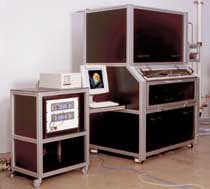
Hinds Instruments Wins Circle of Excellence Award
Exicor DUV
 The development of lithography has been hindered by the lack of a deep-ultraviolet tool to measure birefringence in optical materials such as calcium fluoride. Visible measurement has encountered a high level of intrinisic birefringence in CaF2 at its operating wavelength of 157 nm. Now Hinds Instruments Inc. of Hillsboro, Ore., has designed a deep-UV system that provides low-level birefringence mapping of CaF2 and other optical materials at 157, 193 and 248 nm.
The development of lithography has been hindered by the lack of a deep-ultraviolet tool to measure birefringence in optical materials such as calcium fluoride. Visible measurement has encountered a high level of intrinisic birefringence in CaF2 at its operating wavelength of 157 nm. Now Hinds Instruments Inc. of Hillsboro, Ore., has designed a deep-UV system that provides low-level birefringence mapping of CaF2 and other optical materials at 157, 193 and 248 nm.
The Exicor DUV characterizes and quantifies intrinsic and residual birefringence in optical materials, providing critical information to help minimize aberrations and to qualify lens materials for optical lithography systems.
Its innovations include a photoelastic modulator that employs a proprietary optical material for accurate, efficient and reliable polarization modulation; a dual photoelastic modulator single-detector system that not only measures birefringence angle and mag-nitude simultaneously, but that also is durable and easily aligned; a purge system to minimize the oxygen-free volume; and a control to reduce temperature purge gas differentials in a sample.
The modulator has a wide acceptance angle, enabling measurement of birefringence in lenses when coupled with a large detector. This will be beneficial for telecommunications optics as well as visible and UV lenses.
/Buyers_Guide/Hinds_Instruments_Inc/c6111